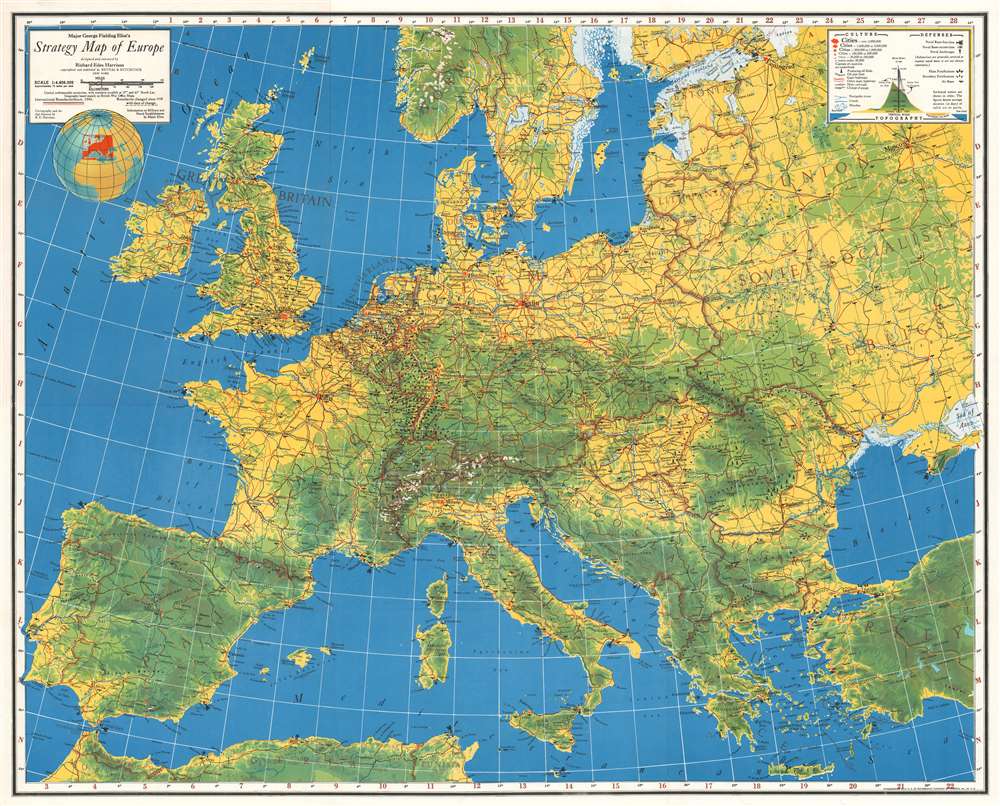1940 Harrison Map of Europe During the 'Phoney War'
StrategyMapEurope-harrison-1940
Title
1940 (dated) 25.75 x 32 in (65.405 x 81.28 cm) 1 : 4800000
Description
Publication History
This map was designed and executed by Richard Edes Harrison, with all information on military and naval establishments was provided by Major George Fielding Eliot. It was published by Reynakl and Hitchcock in 1940.CartographerS
Richard Edes Harrison (1902 - January 5, 1994) was an American cartographer and cartoonist active in the middle part of the 20th century. Harrison is credited with redefining cartography, especially journalistic cartography, by employing spherical perspective, bold shading, and graphic design to both make maps more publicly accessible and give them an artistic dimension. Harrison was born in Baltimore and studied design at Yale, graduating in 1923, before relocating to New York City at the height of the Great Depression. He made ends meet through industrial design work, creating everything from bottles to ashtrays. His first foray into the cartographic world was a fill-in job at Fortune magazine. The editors at Fortune must have admired his work for it launched a long-standing collaboration. His work, doubtless inspired by the age of air travel, became exceptionally popular during World War II, where his unique approach and political charged subject matter illustrated the seats of war with exceptional poignancy and clarity. After the war, Harrison continued to produce maps from his base in New York City. In his spare time he was an avid ornithologist and was commonly seen in Central Park in search of rare bird sightings. More by this mapmaker...
George Fielding Eliot (June 22 1894 - April 21, 1971) was an officer in two separate armies and a police officer, published author, syndicated newspaper columnist, and CBS News military analyst during World War II. Born in Brooklyn, New York, Eliot moved with his parents to Australia at the age of eight. He attended the University of Melbourne where he was a member of the cadet corps. At the outbreak of World War I, Eliot was a second lieutenant in the Australian infantry. He fought in the Gallipoli Campaign from May to August 1915, and was transferred to Europe in 1916 where he fought at the battles of the Somme, Passchendaele, Arras, and Amiens. By the end of the war, he had been wounded twice and held the rank of acting major. He moved to Canada after the war and became a member of the Royal Canadian Mounted Police and served for two years. Eliot then moved back to the United States and became a reserve officer in the U.S. Army reserve and served in military intelligence from 1922 until 1933, eventually attaining the rank of major. He resigned his commission in 1933 in order to have greater freedom to write and comment on military affairs and the impending war. Eliot lived in the central United States during the 1920s and 1930s and worked as an accountant. He began writing pulp fiction and crime novels in 1926. He wrote numerous articles on the war and military strategy during World War II for publications such as Life, The American Mercury, Current History, and Harper's Magazine. He served as a foreign correspondent for CBS and broadcast from London alongside Edward R. Murrow and H. V. Kaltenborn in 1939, and, on December 7, 1941, Eliot was part of both the radio and television coverage of the Japanese attack on Pearl Harbor. CBS broadcast ten hours of television coverage on December 7, making this the first extended television coverage of a breaking news event. Eliot worked as a staff writer for the New York Herald Tribune and continued to write books and articles on military strategy well into the 1960s. Eliot married Sara Elaine Hodges in 1933, whom he divorced in 1942. In 1943 he then married June Caley Hynd. Learn More...

